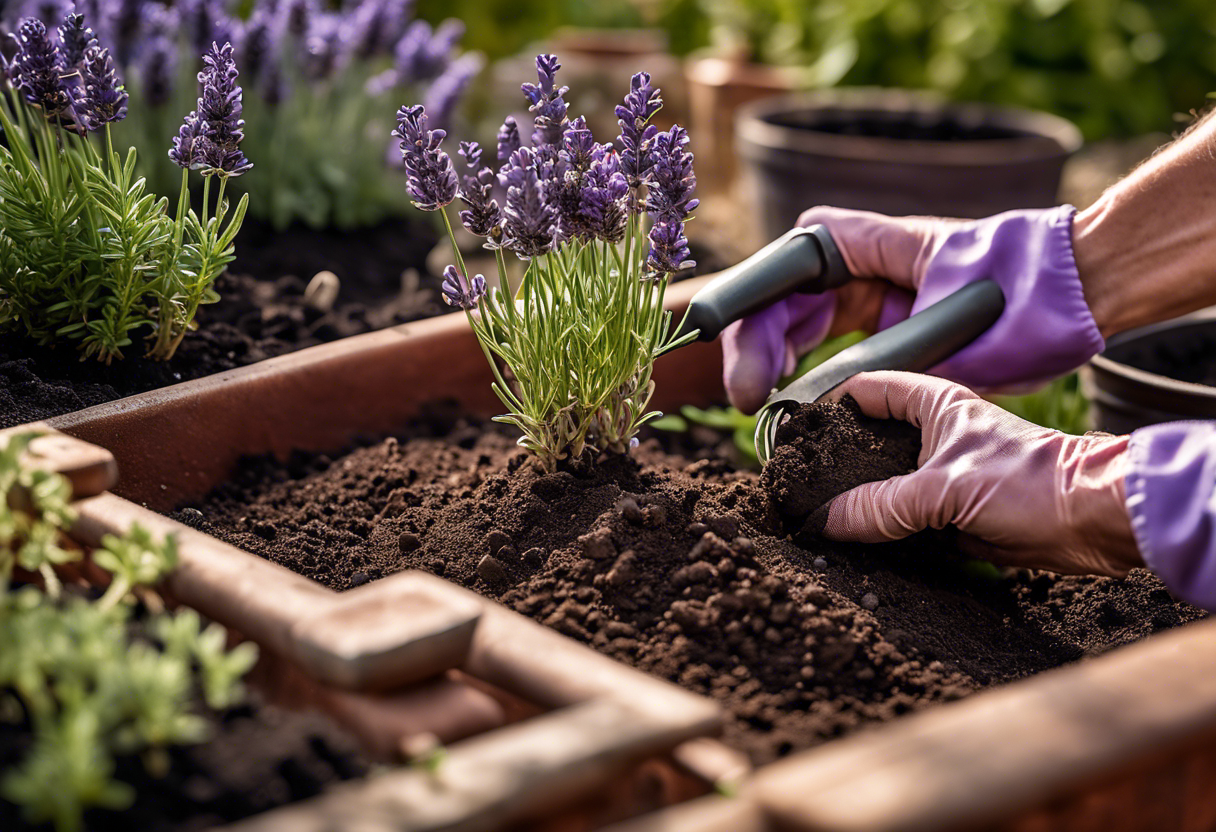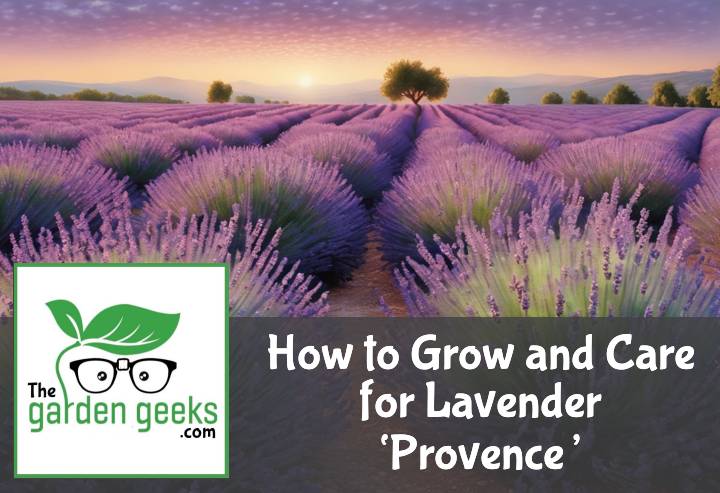Ever been to the South of France and marveled at those endless purple fields, swaying gently in the breeze? Well, that’s How to Grow and Care for Lavender ‘Provence’ in action. It’s like a fragrant purple sea that you just want to dive into!
But hey, who says you need a ticket to Provence to experience this beauty? With a bit of green thumb magic and some handy tips, you can grow your own ‘Little Provence’ right in your backyard. Keep reading about How to Grow and Care for Lavender ‘Provence’.
Key Takeaways
- ‘Provence’ lavender needs full sun and well-drained soil.
- Water it infrequently but deeply, allowing the soil to dry out between watering.
- Prune in early spring or after flowering to maintain shape and promote growth.
- Fertilize with slow-release pellets in the spring.
- Protect from harsh winter conditions by mulching or covering plants.
- Monitor for pests like aphids and treat with insecticidal soap if necessary.
- Propagate through cuttings in late summer.

What is Lavender ‘Provence’?
Lavender ‘Provence’, also known as French lavender, is a favorite among gardeners. It’s an aromatic plant that brings a touch of the Mediterranean to any garden. The popularity of gardening with lavender stems from its hardy nature and the delightful scent it imparts. Now, let’s delve into the specifics of this beautiful plant.
Origin and Characteristics
The origin of Lavender ‘Provence’ traces back to the sunny fields of Southern France. This region, known for its fertile soil and warm climate, provides ideal conditions for these plants to thrive. The physical characteristics of Provence lavender are quite distinctive. Its color varies from a pale lilac to a deep purple, depending on the variety and growing conditions.
The size of these plants can range from compact shrubs perfect for small gardens to larger varieties that make stunning hedges. But what sets Lavender ‘Provence’ apart is its remarkable lavender scent. It’s intense yet soothing, making it a popular choice in aromatherapy and perfumery.
Varieties of Lavender ‘Provence’
There are several varieties of Provence lavender, each with unique traits that distinguish them from one another. Some types have darker flowers, while others might boast longer stems or more robust growth habits.
For instance, one variety might be prized for its oil content, while another might be favored for its resistance to pests or diseases. These differences make each type special in its own way and provide endless possibilities when it comes to gardening with lavender.
Remember folks, knowing how to grow and care for Lavender ‘Provence’ begins with understanding what makes this plant so unique!
How to Plant Lavender ‘Provence’?

When it comes to planting Lavender Provence, there are a few key steps you need to follow. It’s not just about digging a hole and plopping in the plant, oh no! You’ve got to consider the location, prepare the soil, and then get down to the actual planting.
Choosing the Right Location
First things first, let’s talk about lavender location selection. Your lavender isn’t going to be happy if you stick it in a dark corner where it never sees the sun. Nope, these plants love their sunlight! So make sure you’re choosing a spot that gets plenty of sunlight for lavender.
But wait, there’s more! The quality of your soil is also important. You want well-draining soil because lavender doesn’t like wet feet. In other words, don’t pick a spot where water tends to pool after rain. That’s definitely not the best place to plant lavender!
Preparing the Soil
Now that you’ve picked out an ideal spot, it’s time for some groundwork – literally! When we talk about soil preparation for lavender, we’re mainly looking at two things: pH level and nutrients.
Lavenders prefer slightly alkaline soil with a pH between 6.7 and 7.3. If your soil is too acidic or too alkaline, don’t panic! Just grab some garden lime or sulfur from your local garden center and adjust accordingly.
As for nutrients, lavenders aren’t super picky but they do appreciate some compost or organic matter mixed into their new home. This will provide all the nutrients needed by lavender plants without overdoing it.
Planting Process
Alrighty then! We’ve chosen our location and prepared our soil so now it’s time for the main event: planting your Lavender ‘Provence’. The steps to plant lavender are pretty straightforward.
Start by digging a hole that’s about twice as wide and just as deep as the root ball of your plant. Place your lavender in the hole, making sure it’s level with the ground. Backfill with soil, gently firming it around the base of the plant.
Once planted, give your new lavender a good drink of water. But remember, these plants don’t like to be too wet so go easy on the watering can! Just enough to help it settle in and start its new life in your lavender garden setup.

How to Care for Lavender ‘Provence’?
Caring for Lavender ‘Provence’ is a rewarding task. With the right attention to watering, pruning, and pest control, you can maintain healthy lavender growth.
Watering Requirements
When it comes to watering lavender plants, less is often more. Lavender ‘Provence’ hydration needs are moderate. These plants prefer well-drained soil and don’t take kindly to soggy roots.
Overwatering can lead to root rot, so it’s essential to strike a balance. The key is maintaining moisture in lavender plants without making them waterlogged. A good rule of thumb? Water when the top inch of soil feels dry.
Pruning Techniques
Pruning plays a significant role in maintaining lavender plant health. Regularly pruning Lavender ‘Provence’ helps promote new growth and keeps the plant looking tidy.
The best time for pruning lavender is in late summer or early fall, after flowering has finished. Use sharp shears and cut back about one-third of the plant’s height. This technique promotes growth through pruning by encouraging bushier regrowth come springtime.
Dealing with Pests and Diseases
Like any garden superstar, Lavender ‘Provence’ can attract unwanted attention from pests. Common culprits include aphids and whiteflies, but diseases like root rot can also pose a threat.
Preventing pests in lavender gardens starts with good hygiene practices – remove dead leaves promptly and keep an eye out for signs of trouble. If you spot pests or disease symptoms early on, treating diseased lavender plants becomes much easier.
Remember: prevention is better than cure! So keep your eyes peeled and your pruners ready as part of your regular lavender care tips, ensuring that your Lavender ‘Provence’ remains the star of your garden show!
When and How to Harvest Lavender ‘Provence’?
Harvesting Lavender Provence is a delicate art. It’s all about timing and technique. You see, how to grow and care for Lavender ‘Provence’ doesn’t stop at planting and watering. The harvest is just as important.
Identifying the Right Time to Harvest
So, when is the best time to harvest lavender? Well, that depends on a few factors. First off, you gotta check out your plant’s health. If it’s looking vibrant with full blooms, that’s a good sign!
Next up, consider the weather conditions for lavender harvest. You want dry days with little wind – trust me; you don’t want your precious lavender blowing away!
The optimal lavender harvest time usually falls in late spring or early summer. But hey, your lavender will give you signs when it’s ready-to-harvest. Just look for those richly colored buds – they’re screaming “pick me!”
Harvesting Techniques
Now let’s talk techniques for harvesting lavender. You can’t just go in there all willy-nilly; you need the right tools for lavender harvest.
A sharp pair of garden shears should do the trick nicely. And remember folks, always cut above the wood – this helps ensure healthy post-harvest lavender care.
Effective lavender harvesting methods also include preserving Lavender Provence post-harvest by hanging them upside down in a cool, dark place – like a vampire! This keeps their scent potent and color vibrant.
So there you have it folks! That’s how you nail the proper lavender harvest. Happy snipping!
How to Use Harvested Lavender ‘Provence’?
Once you’ve mastered how to grow and care for Lavender ‘Provence’, the next step is using it. Whether dried, stored, or fresh, this versatile plant has a multitude of uses.
Drying and Storing
Harvesting Lavender ‘Provence’ isn’t just about snipping off the stems. To maintain its quality, proper drying and storing techniques are crucial. Start by cutting long stems during the morning hours when oils are at their peak.
Then, bundle them together and hang upside down in a dark, dry place with good air circulation. This method helps preserve the lavender’s color and scent. After drying for about two weeks, store your lavender in an airtight container away from direct sunlight.
Remember, properly dried and stored lavender can last up to a year! So take your time to do it right.
Uses in Cooking, Crafts, and Health
Now that you have your harvested Lavender ‘Provence’, let’s talk about its applications. In cooking, lavender adds a unique flavor profile to dishes like lamb or desserts like ice cream.
Craft-wise? Oh boy! From potpourri to wreaths, there’s no limit to what you can create with lavender crafts ideas. And let’s not forget its health benefits – from soothing anxiety to aiding sleep.
So whether you’re a foodie looking for new flavors or a DIY enthusiast seeking inspiration, Lavender ‘Provence’ has got you covered!

To Wrap Up
We’ve journeyed through the lavender fields of How to Grow and Care for Lavender ‘Provence’, ain’t that a fragrant ride? Remember, caring for this plant is like babysitting a goldfish – it needs just the right amount of love and attention.
So get your green thumbs ready, folks! Let’s turn our gardens into a mini Provence. After all, who doesn’t want their backyard smelling like a French summer?


